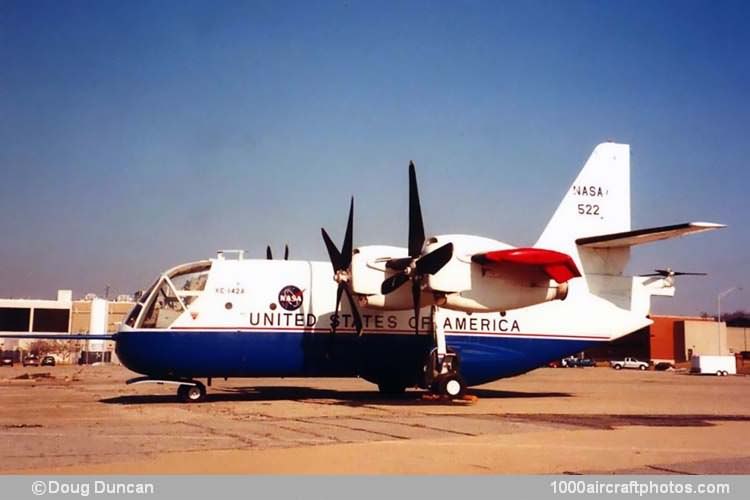11/30/2010. Remarks by Johan Visschedijk: "The VHR-447, a tilt-wing aircraft design study entered jointly by Vought, Hiller and Ryan in the design competition for a VTOL transport for the US armed forces in January 1961, was announced winner the following September. The aircraft was intended as part of a system for the rapid transport of combat troops, equipment and supplies from assault ships or airfields into unprepared areas under all-weather conditions.
Five prototypes and a static test airframe were ordered in January 1962, under the military designation XC-142A, and the tilt-wing transport development program was under USAF management, hence the aircraft received the USAF serials 62-5921 to 62-5925.
Ling-Temco-Vought (Vought merged August 31, 1961 with Ling-Temco) was prime contractor, Ryan was responsible for design and construction of the rear fuselage assembly, the wings, and the engine mountings and nacelles. Hiller was responsible for design and manufacture of the flaps, ailerons, power transmission systems, gearing, shafting and propellers. The remainder of the airframe was designed and built by LTV.
The four General Electric T64 turboprop engines drove conventional propellers and a horizontally-mounted three-blade variable-pitch tail rotor through a system of cross-shafting and gear trains, and it would be possible to maintain flight on any two engines in an emergency. The wing was able to rotate through an angle of 100°, giving the XC-142A ability to hover in a tail-wind.
During VTOL flight, roll control was achieved by means of differential collective propeller pitch, yaw control by means of the ailerons working in the propeller slipstream, and pitch control by means of the variable-pitch tail rotor. During transition a mechanical mixing linkage integrated the VTOL control system with the conventional ailerons and tail control surfaces in correct proportions as a function of wing tilt angle. In normal cruising flight, control was by the conventional control surfaces, with the tail rotor locked. A dual four-function stabilization system ensured stability during IFR flight, hovering and transition.
The first conventional flight of the XC-142A was made successfully on September 29, 1964. The first hovering flight followed on December 29 and on January 11, 1965, the aircraft performed its first two conversions, from hover to horizontal flight and return. On February 4, 1965, two XC-142As gave a public demonstration of their capabilities in vertical and conventional flight, as well as performing backward flights and 360° rotations in the hovering condition.
By February 4, 1967, the five XC-142As had logged a total of 350 hours in the air, in 420 flights. One aircraft had reached a height of 25,000 ft (7,620 m) during a test flight. Airspeeds have ranged from 35 mph (56 kmh) backward in hover to 400 mph (644 kmh) in forward flight. On May 18, 1966, an XC-142A made 44 short take offs and landings and six vertical take offs and landings on the US aircraft carrier Bennington off the coast of California, while the ship was under way.
Another of the aircraft has carried out an air drop program at El Centro Air Station in the California Desert. From heights of 5 ft (1.5 m) to 5,000 ft (1,500 m) and forward speeds of zero in hover to 144 mph (232 kmh), dummy cargo loads weighing up to 4,000 lb (1,815 kg) were dropped. One technique, known as "dump truck" off-loading, involved discharging cargo mounted on rollers from the rear end of the aircraft, with the fuselage tilted upward several degrees, during low-speed flight and while hovering.
The first aircraft, s/n 62-5921 crashed on May 10, 1967 due to fault in tail pitch rotor, while the fourth, s/n 62-5924, had been transferred to NASA a year earlier. Coded "522", it was operated at Langley Field, Virginia to investigate additional flying qualities of a tilt-wing airplane. On May 4, 1970, it was ferried to the Air Force Museum where it was put on display, still in NASA markings."
